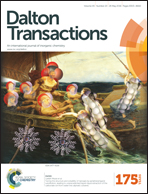Postsynthetic modifications of [2,2,2-(H)(PPh3)2-closo-2,1-RhSB8H8] with Lewis bases: cluster modular tuning†
Abstract
It has been demonstrated that the reaction of [2,2,2-(H)(PPh3)2-closo-2,1-RhSB8H8] (1) with PPh3 affords the boron substituted rhodathiaborane–PPh3 adduct, [6,6-(PPh3)2-9-(PPh3)-arachno-6,5-RhSB8H9] (2). Building upon this reaction, we report herein that the 10-vertex hydridorhodathiaborane 1 reacts with the Lewis bases, PCy3, py, 2-Mepy, 2-Etpy, 3-Mepy and 4-Mepy to form the rhodathiaborane–ligand adducts, [6,6-(PPh3)2-9-(L)-arachno-6,5-RhSB8H9], where L = PCy3 (3), 2-Mepy (4), 2-Etpy (5), py (6a), 3-Mepy (7a) or 4-Mepy (8a), and [8,9-μ-(H)-9-(PPh3)2-8-(L)-arachno-9,6-RhSB8H8], where L = py (6b), 3-Mepy (7b) or 4-Mepy (8b). The selectivity of the reactions depended on the nature of the entering Lewis bases, affording the 6,5-isomers, 2, 3, 4 and 5 as single products for PPh3, PCy3, 2-Mepy and 2-Etpy; and mixtures of the 6,5-/9,6-regioisomers, 6a/6b, 7a/7b and 8a/8b for py, 3-Mepy and 4-Mepy, respectively. The molecular structures of both regioisomers were characterized by X-ray diffraction analysis for the 6,5-isomers, 3 and 4, and for the 9,6-isomers, 7b and 8b. Variable temperature NMR studies of the reaction between 1 and PPh3 or 2-Mepy demonstrated that at low temperatures there is formation of the 9,6-species that subsequently isomerizes to the 6,5-regioisomer, indicating that for the more sterically hindered Lewis bases, PPh3, 2-Mepy and PCy3, the latter isomer is more stable and accessible through an intramolecular {Rh(PPh3)2} vertex flip. The formation of both isomers with py, 3-Mepy and 4-Mepy indicates that the kinetic and thermodynamic energies of the 6,5 and 9,6 rhodathiaborane–ligand adducts are similar for these Lewis bases. Lewis base bonding to exo-polyhedral boron vertices results in a change of the metal coordination from pseudo-octahedral Rh(III) in 1 to pseudo-square planar Rh(I) in the adducts. The chemistry described here highlights the remarkable structural flexibility of these polyhedral boron-containing compounds, their modular architecture and their easy postsynthetic modification.
![Graphical abstract: Postsynthetic modifications of [2,2,2-(H)(PPh3)2-closo-2,1-RhSB8H8] with Lewis bases: cluster modular tuning](/en/Image/Get?imageInfo.ImageType=GA&imageInfo.ImageIdentifier.ManuscriptID=C6DT00856A&imageInfo.ImageIdentifier.Year=2016)

 Please wait while we load your content...
Please wait while we load your content...